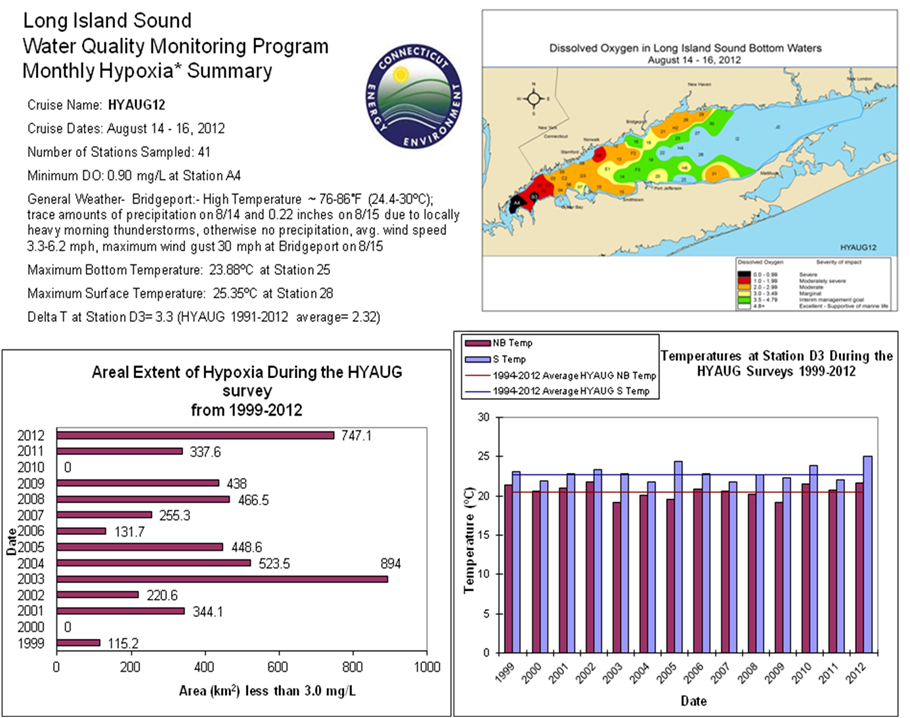Western and central Long Island Sound has suffered from bottom water hypoxia for a long time. The CT Department of Energy and Environmental Protection has monitored dissolved oxygen contents in the Sound for decades. This data shows oxygen depletion in bottom waters from June through September, with the worst conditions typically in July and August in the extreme western end of the Sound.
This condition is referred to as hypoxia or the low oxygen “dead zone.” Hypoxia is defined as water where its dissolved oxygen content is below three milligrams per liter. Anoxic water has less than one milligram of oxygen per liter. Water in equilibrium with the atmosphere will saturate with oxygen dependent on the water temperature (dissolved oxygen decreases with increasing temperature). Surface waters may be oversaturated with oxygen during days with intense sunlight, but this excess oxygen diffuses from the surface waters back into the atmosphere.
There are two fundamental causes of oxygen depletion in the Sound’s bottom waters:
- Vertical water stratification that develops during the summer .
- Dissolved oxygen consumption through the oxidation of organic material.
The summer water stratification results from the warming of the surface waters during the summer as well as decreased salinity. The latter results from the input of the spring snow melt from up north through the rivers and seasonally higher precipitation rates in late summer. The warmer, less saline surface water then “floats” like a lid on top of the cooler, more saline (denser) bottom waters, preventing the bottom waters from acquiring “new” oxygen from the atmosphere. In summary, the top and bottom waters do not mix very much during the late summer, but the fall cooling causes water mixing again. The oxygen consumption rate in the deeper waters is modulated by the abundance of “rotting” organic material, the debris of locally produced algae (mainly diatoms in the Sound) and the influx of solid organic material from land (leaves, grass) as well as solid carbon debris from waste water treatment facilities. The oxidation of this organic material consumes dissolved O2 until it is fully depleted in the water, and other pathways of organic carbon mineralization then take over.
The simple fact thus is: bottom waters become hypoxic or anoxic when the rate of oxygen consumption (organic matter oxidation) outstrips the rate of oxygen supply (mixing of surface waters with deeper waters).
So how have human activities impacted these two rates?
Summers have always been warmer than winters, so has the Sound always had seasonal hypoxia throughout its 10,000 year history? Studies of sediment cores provide insight on the early history of Long Island Sound water quality. A warm period occurred about a thousand years ago (Medieval Warm Period), but there is no evidence for hypoxia at that time, suggesting that the warm waters alone are not responsible for the hypoxia. The sediment cores strongly suggest that the hypoxia started with the colonization and population growth of Connecticut and New York in the mid-1800s. A generally accepted view is that the fertilization of the Sound with nutrients from human and animal waste (especially nitrogen) caused enhanced biological productivity and all that organic matter created a much larger oxygen sink in the bottom waters.
To improve the water quality, the CTDEEP and New York State Department of Environment Conservation created a TMDL (Total Maximum Daily Load) for nitrogen for the Sound, aiming at a reduction of close to 58 percent of nitrogen inflows by 2014. Connecticut’s nitrogen contributions have diminished dramatically over the last decades, but the hypoxia did not improve concurrently.
We could ask if the water stratification is stronger now than it was in centuries past, given the changes in land use (more water runoff from land through more impervious surfaces) and global warming may have enhanced water stratification as well. In addition, the cutback in nutrient flows to the Sound only reduces the local algal productivity but the carbon flow from land may still be much higher than that in the past. And last but not least, the stack of sediment of the last 100 years is rich in shallow buried organic matter and may still constitute an oxygen sink for bottom waters.
The trends in duration and spatial extent of Long Island Sound hypoxia over the last few decades show periodic variations but little significant long term trends. Climate variation, including strong winds that cause short term summer mixing, may now be the main driver of the extent of hypoxia in Long Island Sound. Nonetheless, the fertilization of the Sound provides the fuel for the hypoxia, and reduction of that excess nitrogen flow will be the main factor for the improvement of the condition of oxygenation of the Sound waters.
Today’s guest post is by Johan Varekamp, Ph.D., CFE/Save the Sound’s board president and Professor of Environmental Studies at Wesleyan University.


1 thought on “Guest Post: The Science of Hypoxia”
Comments are closed.